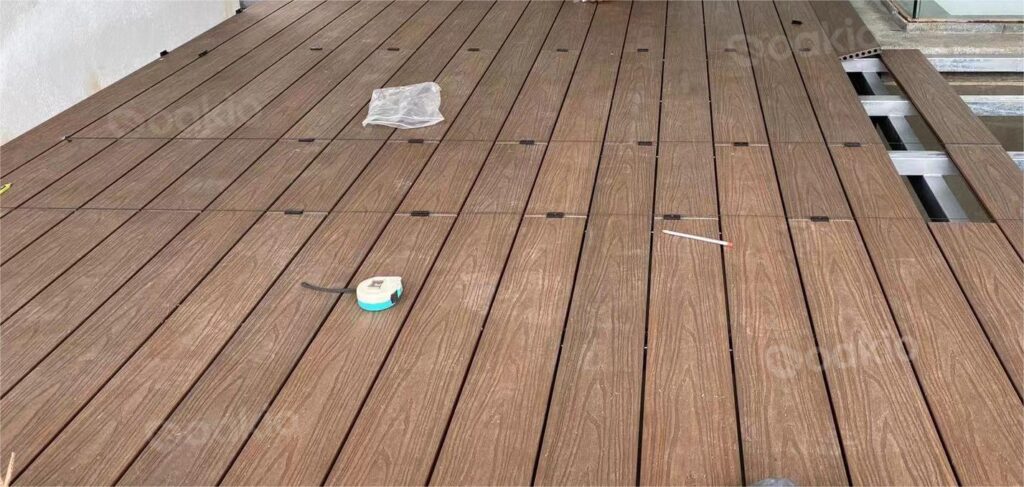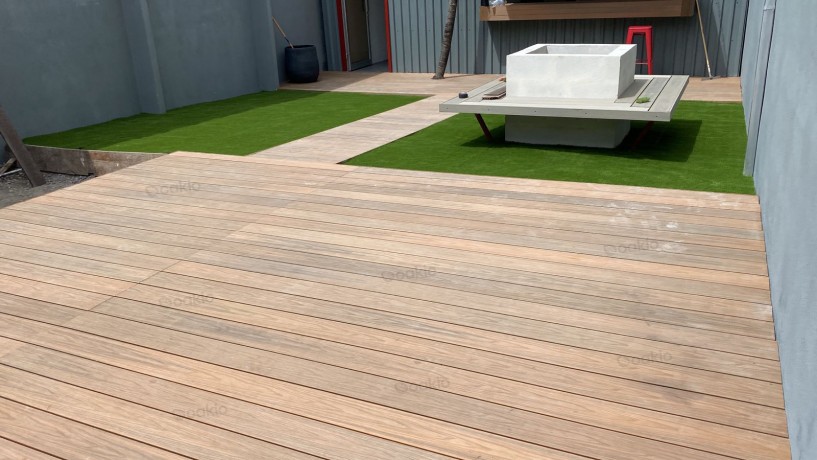WPC Flooring: The Ultimate Guide for Homeowners
WPC is one of the most popular flooring materials in modern construction. WPC floors are made of Wood Plastic Composite, a material whose core comprises wood fibers and plastic polymers. WPC flooring is designed to last a long time, is easy to install, and has incredible customizability.
However, despite this popularity, a first-time buyer of WPC flooring may feel overwhelmed by their options. This Oakio guide will discuss what WPC flooring is—its features, benefits, installation, and maintenance.

What is WPC Flooring?
Wood Plastic Composites are more durable, water resistant, versatile, and easy to maintain. For instance, if your floors get more foot traffic than the average home, a WPC floor is ideal. This type of flooring consists of four main layers:
- Backing layer: The lowermost layer of its plank provides a sturdy base. Sometimes, it also includes an attached underlayment for added convenience.
- Core layer: The most important layer of WPC flooring, the core layer is crafted to be solid and waterproof, lowering the chances of staining, swelling, or warping.
- Printed vinyl layer: This layer is your flooring’s outer surface, which is often given the appearance of other materials, such as wood or stone.
- Wear layer: Lastly, this layer is responsible for protecting your flooring’s surface from wear and tear.
It is also important to note that WPC vinyl flooring’s waterproof properties make it suitable for the toughest conditions, even on top of average home use. For instance, if you manage a food business, this type of flooring is recommended. They also work best in high-moisture areas, such as laundry rooms and basements.
What Are the Benefits of Choosing WPC Flooring?
WPC flooring offers a wide range of benefits, from durability to comfort.
Durability and Longevity
This type of flooring is renowned for its outstanding durability, making it highly suitable for areas that may encounter water exposure more often. WPC is sustainable and requires minimal maintenance.
Furthermore, WPC flooring has a lifespan of 20 to 25 years on average and this is primarily because of its wood fiber and plastic composition, which makes it highly resistant to rot, mold, mildew, and pests.
Aesthetic Versatility
While WPC flooring isn’t completely made out of wood or stone, it can mimic the appearance of those materials. Thanks to advanced printing technology, they can make you feel you are having real stone or wood without the need to spend more or maintain the floor frequently.
Comfort Underfoot
In addition, a WPC flooring’s thicker core adds cushioning and flexibility, providing you with a softer and more comfortable feel underfoot than the more rigid wood or stone floors.
Where to buy WPC flooring? The industry’s most innovative WPC floors are at Oakio. This pioneering developer and manufacturer of composite decking, fencing, cladding, pergola, and railing is committed to sustainability. View the Oakio catalog today.
How Do You Install WPC Flooring?
Once you have your WPC flooring materials with you, you can now begin construction. Here is a concise guide on how to install WPC flooring.

Installation Methods
DIY enthusiasts can certainly try installing WPC flooring on their own, especially since the material is fairly easy to work with. The revolutionary click-lock installation system makes it suitable for home improvement projects. It requires no gluing, so you can ensure they are installed accurately and evenly without unnecessary gaps.
Preparation Steps
Before proceeding to the installation, you need to ready a few things. First, the subfloor must be cleaned and freed from any debris. Additionally, it must be flat within around ³⁄₁₆ inches over a 10-foot span. Any unevenness must be sanded down or filled with a floor leveler. You may need to ask a professional to do this for you.
You must also dry the subfloor. Any carpet stapes or adhesive residue must be removed. If you are installing WPC flooring over soil, make sure it is compacted.
Post-Installation Care
There are three important words to remember when caring for your WPC floor post-installation: cleaning, sunlight, and protection. This type of floor must be cleaned regularly using a vacuum, or water and soap. No harsh cleaners must be used to prevent scratches.
It is likewise important to remember that WPC floors must be away from direct sunlight. Rooms with this type of flooring must have curtains, blinds, drapes, or solar film. You may also place mats on the floor.
How Do You Maintain Your WPC Flooring?
Regular Cleaning Tips
You won’t need an extensive range of cleaners to keep your WPC flooring in its best condition. Use soap and water for stains, then a gentle brush for scratches, nicks, cuts, and grooves. WPC floors are generally low-maintenance so you can keep it looking great with a regular vacuum cleaner and damp mop.
However, it is important to dry mop and vacuum the floor first before wet cleaning. Sometimes, you may also use diluted apple cider vinegar to treat stubborn dirt and grime stains, jojoba oil to remove scuffs, and baking soda to remove food stains.
Avoiding Damage
WPC floors are beautiful but they be scratched and dented if not cared for properly. When moving heavy furniture, place pads underneath so your WPC floor won’t get scratched. You must also avoid harsh chemicals, such as ammonia and bleach.
Long-term Care
Caring for WPC flooring primarily revolves around careful observation. Observing the signs of damage, and addressing them as they come along is one of the best maintenance measures as it prevents issues from becoming too severe.
Conclusion
Familiarizing yourself with WPC flooring care can save you from a lot of complications down the line. Though this type of flooring has many advantages, it is important to follow the right installation processes and maintenance steps.
Oakio is a leading innovator in composite wood manufacturing, providing well-designed and sustainable products, such as decks, fences, cladding, pedestals, pergolas, and more. The brand is known for its new-generation co-extrusion composite, Elashield, and Armstrong technologies, ensuring that the materials are crafted to last. For more tips, how-tos, and exclusive deals, sign up for the Oakio newsletter.
Trending Reading
What Are the Differences Between the WPC Board and PVC Board?
[2024 Update] How Long Does WPC Decking Last?













